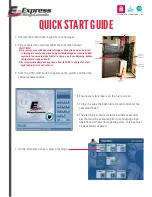
SlimLine Force Sensor, Type 9173B to 9177B
Page 40
9173B_002-286e-07.10
In their dynamic behavior, piezoelectric sensors are superior
to all other measuring methods. Their high rigidity results
in the highest possible natural frequencies. Piezoelectric
sensors are thus ideal for measuring measurands which
change rapidly over time. Their dynamic behavior is
thereby largely determined by the surrounding structure.
Therefore the frequency response of the entire measuring
arrangement must be investigated for the largest possible,
useful measuring range.
There are two possibilities here:
Frequency analysis
The measuring arrangement is stimulated e.g. with an im-
pulse hammer and the sensor output signals then subjected
to a frequency analysis. The results is presented in terms of
an amplitude and phase response curve
FEM
Finite Element Method: Finite Element Method (FEM) is a
numerical procedure for the approximate solution of differ-
ential equations having boundary conditions. Using the FE-
Method, various problems from physical areas can be cal-
culated. A computing field obtains an arbitrary number of
elements, however, being finite in size and number.
Note: In the finite element method, a homogeneous body
is substituted for the sensor closely approximating to the
dimensions and average density of the sensor. The average
modulus of elasticity of this equivalent body is then con-
tinuously varied until its natural frequency coincides with
that of the actual sensor (technical data). An equivalent
body defined in this way is usually a good approximation
of the sensor. The equivalent substitute body is inserted
into the structure to be simulated, and by this means the
natural frequency of the structure is calculated. Using this
procedure, the FEM can be used to determine the fre-
quency behavior of a measuring arrangement with good
approximation
9.5
Influence of Temperature
Temperature changes during a measurement result in an
error signal in the form of a zero drift. In critical applica-
tions, we recommend that protection be provided for the
sensor as far as possible against changes in temperature.
Temperature error of the zero point (static error)
Temperature error [unit of the measurand/°C] is the great-
est change to the output signal in a specified measuring
range after a specific sensor temperature change, following
which the sensor is again in thermal equilibrium with its
environment. Temperature errors are caused by changes in
stress in the sensor, which in turn are influenced by the
preload or installation conditions.
Summary of Contents for 9173B
Page 1: ...Instruction Manual SlimLine Force Sensor Type 9173B to 9177B 9173B_002 286e 07 10...
Page 2: ...Instruction Manual SlimLine Force Sensor Type 9173B to 9177B 9173B_002 286e 07 10...
Page 27: ...Calibration and Maintenance 9173B_002 286e 07 10 Page 25 Fig 12 In situ calibration procedure...



































